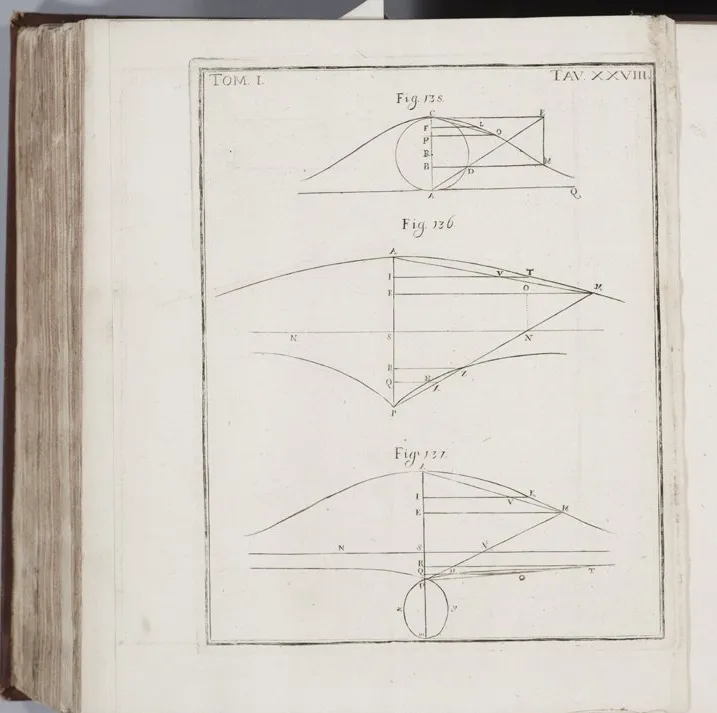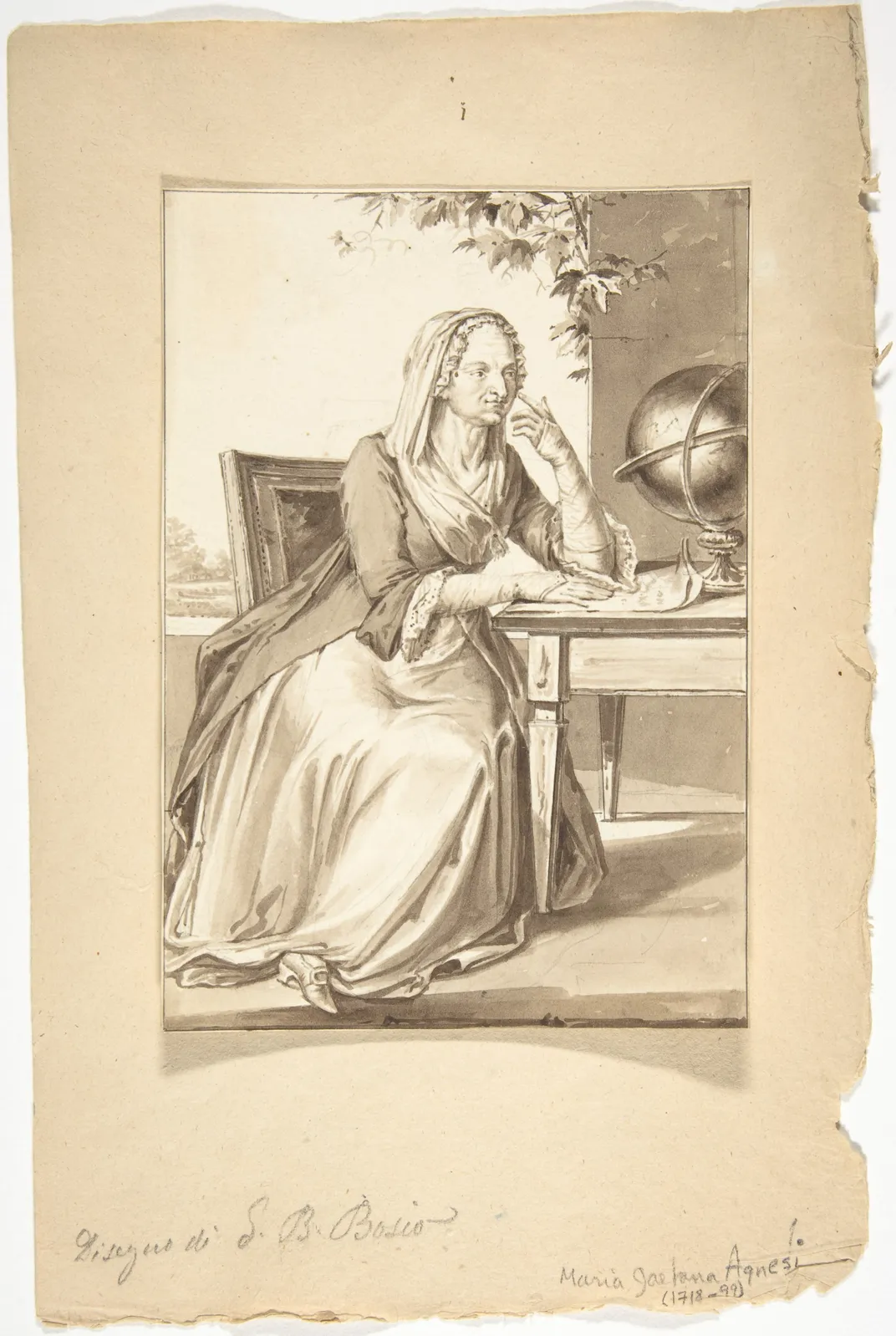The 18th-Century Lady Mathematician Who Loved Calculus and God
After writing a groundbreaking math textbook, Maria Agnesi quit math for good
/https://tf-cmsv2-smithsonianmag-media.s3.amazonaws.com/filer/7c/a4/7ca4762d-8448-40ef-8680-6739305f266c/agnesi-wr.jpg)
The witch of Agnesi, you may be disappointed to know, is a curve that math students generally learn about in calculus class. It doesn’t look much like a witch, or a hat or even a broomstick. It’s nothing more than a gentle, sloping curve.
If a modern math textbook says anything about the Agnesi for whom it is named, it will probably note that Maria Gaetana Agnesi was an 18th-century mathematician who became the first woman to write a major calculus textbook. It may also note that the name is a mistranslation of the Italian versiera, a term the mathematician Guido Grandi had coined based on the Latin for “turning curve,” which translator John Colson mistook for “avversiera,” which means she-devil—or, more succinctly, witch.
That a devout Catholic woman who dedicated decades of her life to serving the poor should be perpetually associated with a witch via a curve she didn’t even invent is ironic to say the least. But in some ways it feels fitting. “It really is like a Freudian slip of the mathematical imagination to make the Italian word ‘curve’ into the Italian word for a diabolically possessed woman,” says Stanford University science historian Paula Findlen. “It’s a great mathematical joke.” Whether he was being deliberately punny or not, Colson’s mistranslation has cemented Agnesi’s place in calculus classes.
Reading Agnesi’s biography, one gets the feeling that she was constantly living in the shadow of society’s and her family’s expectations and desires for her. Yet if we avoid the temptation to interpret her through our own lenses, we can begin to understand her on her own terms.
Born in 1718, Agnesi was the oldest child of Pietro Agnesi, a wealthy Milanese silk merchant. Her education probably began accidentally when tutors came by to instruct her younger brothers. She was a precocious student, particularly in the study of languages, and Pietro quickly recognized her talent. Eager to elevate his family’s social status, he would have her and her musical prodigy sister Maria Teresa perform for guests at salons in the Palazzo Agnesi. Gaetana would speak about topics in science and philosophy in several different languages, and her sister would play music, often of her own composition. Pietro used his talented daughters to make his house an important stop in Milanese social circles.
The Agnesi sisters were two of several girl prodigies from northern Italy from around the same time. Laura Bassi (1711-1778), a physicist from Bologna who became the first woman university professor in Europe, had been a child prodigy as well. Massimo Mazzotti, a science historian at the University of California at Berkeley who wrote the book The World of Maria Gaetana Agnesi, Mathematician of God, calls it a strategy “of fashioning and controlling this phenomenon of the learned woman.” Wealthy families would provide their daughters with a limited education—literature, French, religion—but women could not attend school outside the home.
The phenomenon of the girl prodigy “was one way of signaling talent and exceptional capacity and giving it some kind of socially acceptable form in a world that, strictly speaking, wouldn’t accept women in any of the places in which knowledge was being made and taught,” Mazzotti says.
Yet Mazzotti notes that Agnesi’s status as a child prodigy—coupled with her father’s wealth and ambition—did open “little windows of possibility” that allowed her to become educated and have more say in the direction of her life than many women of the era.

When her mother died in childbirth in 1732, Agnesi was able to scale back her public performances, spending more time taking care of her younger siblings and increasingly influencing the course of her own education. In 1739, she told her father she wanted to become a nun. He balked, but agreed to let her spend more time studying mathematics and theology. “She kind of emancipates herself from this straitjacket of being the performing scientific woman in Milan,” Findlen says. Agnesi never entered a convent, but she also never married or had children, taking an alternate path as a lay Catholic who devoted her life to acts of charity.
At just 30 years old, Agnesi made her crowning mathematical achievement: the publication Instituzioni analitiche ad uso della gioventù italiana (Analytical Institutions for the Use of the Italian Youth), a calculus textbook published in 1748. This hefty two-volume work is a treatment of differential and integral calculus. The first volume is a treatment of the algebraic framework needed to understand the calculus in the second volume. The first Italian youth she was hoping to reach may have been her younger siblings: Pietro had 21 children by his three wives, though few of them survived to adulthood.
If a modern calculus student opened Maria Agnesi’s Analytical Institutions, the language would sound a bit old-fashioned, but the general approach would be familiar. In fact, that familiarity makes it difficult for modern math students to understand the full importance of Agnesi’s work. At the time, most people considered calculus to be important because of its utility in physics, and contemporary calculus books were more or less collections of problems in applied mathematics. Agnesi was interested in calculus as an intellectual pursuit for its own sake, a way to hone the logical faculties. Her book was one of the first not to focus on physics applications.
“It is a book that was born with a different idea in mind of why mathematics is interesting and useful,” Mazzotti says.
In addition, the book was written in Italian, at a time when Latin was still the default language for scholarship. Agnesi wrote it in the common tongue because she wanted the book to be accessible to less educated students. Despite this—and the fact that it was written by a woman—it gained the respect of mathematicians around Europe as an unusually clear treatment of the subject. Decades after it was published, the mathematician Joseph-Louis Lagrange recommended its second volume as the best place to go for a thorough treatment of calculus.
Analytical Institutions has since been translated into English and French. In the preface to the 1801 English version, the editor writes that the volumes “are well known and justly valued on the Continent” and that the primary translator of the work, the late Reverend John Colson, Lucasian Professor of Mathematics at the University of Cambridge, “was at the pains of learning the Italian Language, at an advanced age, for the sole purpose of translating that work into English; that the British Youth might have the benefit of it as well as the Youth of Italy.”

Agnesi lived until 1799. Yet some articles about Agnesi, Findlen says, “basically treat her as if she died the moment she ceased to be scientifically interesting.” After the publication of Analytical Institutions, she gradually retreated from mathematical life. She is sometimes described as the first woman mathematics professor, but she never professed, or even visited the city of her professorship. Pope Benedict XIV, who had helped Bassi gain her position, offered Agnesi an appointment at the University of Bologna as well, and for years she had an honorary position there. When her father died in 1752, she finally felt free to devote herself to studying theology and doing charitable works. Eventually she became the director of the women’s section of the Pio Albergo Trivulgio, a shelter for the poor and sick.
Agnesi does not fit neatly into boxes. For one thing, her religious fervor can seem a bit unsettling to modern sensibilities. Though today we often think of science and religion as conflicting, many of the important figures in European science history, especially before the 19th century, were Jesuits or members of other religious orders. Isaac Newton himself, in between inventing calculus and revolutionizing physics, wrote treatises on alchemy and religious topics, including hidden messages in the Bible. In Agnesi’s day, it was thought that intellectual pursuits could be a form of devotion to God. Agnesi was interested in the work of Nicolas Malebranche, who had written that “attention is the natural prayer of the soul.” Studying a subject like calculus deeply was, to Agnesi was a form of prayer.
Her attitude, says Mazzotti, was that “intellect was necessary for being a good Christian. If you work on strengthening your intellect, you’re doing a good thing for your spiritual life as well.” In later life, her religious writing turned mystical, but when she was most active in mathematics, her approach to religion was more intellectual and rational. Even as her religious practice became more mystical, however, she still saw intellect and passion as two complementary parts of religious life. “The human mind contemplates [the virtues of Christ] with marvel,” she wrote in an unpublished mystical essay, “the heart imitates them with love.”
For another, Agnesi’s choice to leave mathematics can be confounding for those who want to make her an icon in the history of women in science. “She’s one of these rare women who gets to do science, but what does she want to do when she does all this? She wants to give it up,” Findlen says. “We don’t want to see our scientists do interesting things and then give it all up for love of God. it’s not a modern trajectory.”
“Her biography has been kind of split” between those who see her as a quasi-saintly figure in the Catholic church, particularly near her hometown of Milan, and historians of math and women in science, says Mazzotti. “Often these two groups of people have almost no exchange.” As he notes in the introduction to his book: “I first came across Agnesi as a child, while running up and down the nave of San Nazaro [a basilica in Milan].” Because of her famous piety and charity, she was pictured on the church booklets. Later, studying the history of calculus, he wondered how to connect the woman he had seen in a church to the early mathematician.
Reading her story, one gets the sense that Agnesi was straining against the limitations of a society that still could not accept female scholarship and agency. But within the rigid confines of her position in the world, she was able to carve out her own path. She was neither a nun, nor a wife and mother. She was respected by society for both her mathematics and her charitable work as a lay Catholic woman. She both acquiesced to and rebelled against her family’s wishes for her. “To us she seems so conservative, so not modern, and certainly not radical,” Findlen says, “but maybe that’s just the limits of our own understanding of her world.”